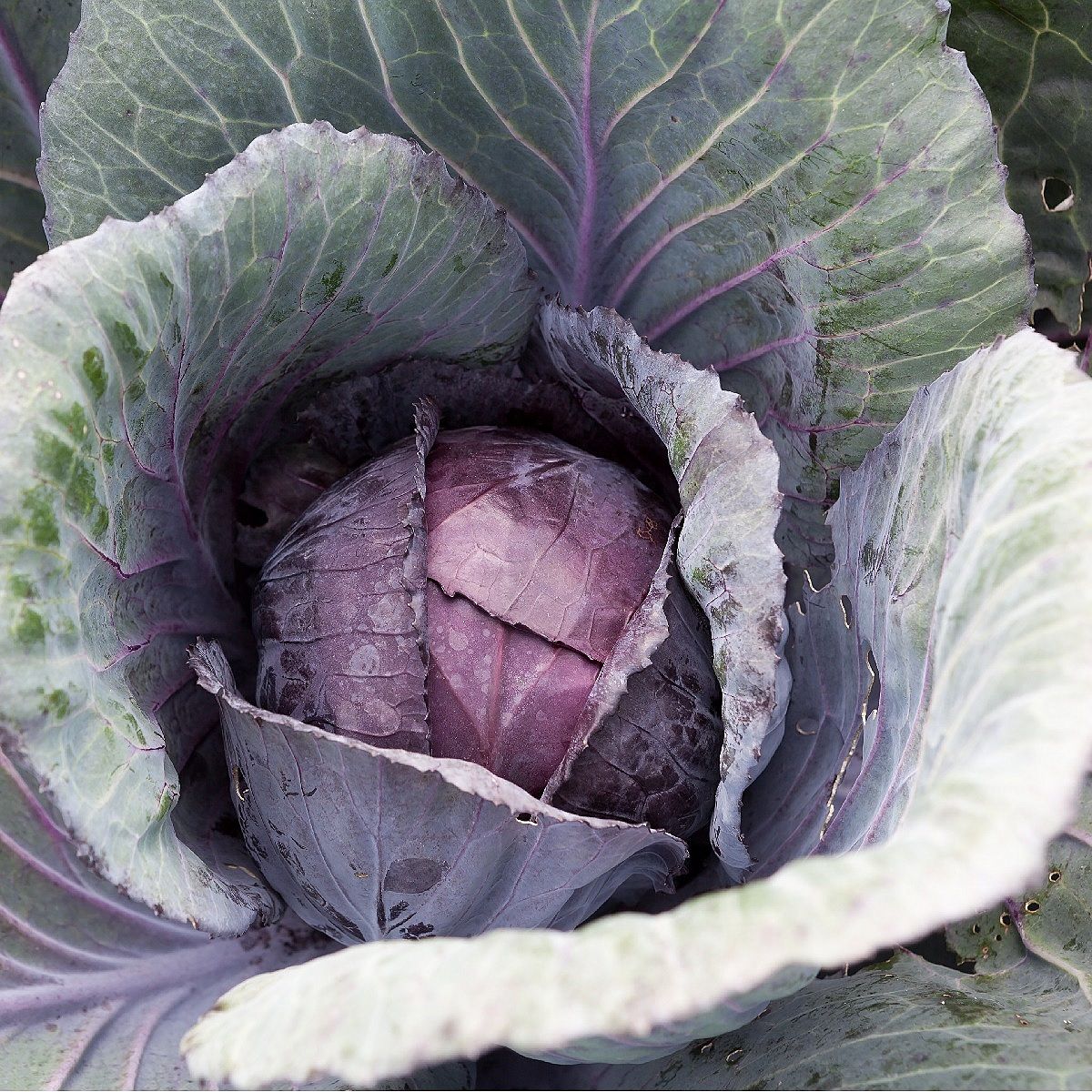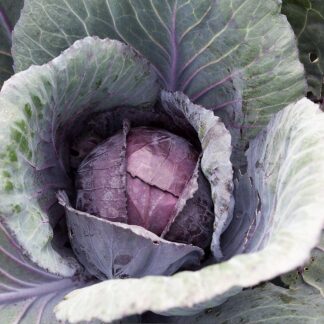Description
Red Acre Cabbage (A.K.A. Red Express Cabbage)
100 Seeds per pack
Days to Maturity:75-100 Days
Sun Requirements: Full sun; tolerates light shade in hot climates.
Botanical Name: (Brassica oleracea)
A long-standing favorite in home gardens, Red Acre is a compact, dependable heirloom noted for its striking reddish-purple heads and excellent disease resistance. First bred for its early maturity and uniform growth, this variety has been passed down through generations for good reason!
Heads reach 6 to 7 inches across and typically weigh between 2 to 4 pounds—just the right size for small home gardens. Plants grow to a tidy height of 12 to 14 inches, with a spread of 12 to 24 inches, making them easy to manage even in compact garden rows.
The flavor is both sweet and earthy, with a hint of pepper—mild and refreshing when raw, and deep, rich and flavorful when cooked. Its crisp texture holds well in slaws and salads, and lends itself beautifully to braising, stews, stir-fries, and fermenting. Unlike many cabbages, Red Acre retains much of its vibrant color even after cooking.
Red Acre stores remarkably well—lasting several weeks in the fridge or even longer in a cool, moist cellar—and holds firm in the garden without splitting or bursting. Rich in vitamins C and K, along with folate and fiber, this all-purpose cabbage is as nourishing as it is flavorful!
Disease Resistance: Resistant to Fusarium yellows and other common cabbage diseases. Also noted for its resistance to splitting, making it a reliable choice even in variable garden conditions.
Planting Instructions for Red Acre Cabbage Seeds
When to Plant:
Start seeds indoors 4–6 weeks before your last expected spring frost for a summer crop. For a fall harvest, start seeds indoors or direct-sow in the garden about 10–12 weeks before your first expected autumn frost. In northern zones, spring seedlings should be started indoors in early to mid-April. In warmer climates, you may direct-sow in midsummer for a fall crop.
How to Start Indoors:
Sow seeds ¼″ deep in trays or cells filled with a fine, sterile seed-starting mix. Plant 2–3 seeds per cell, then thin to the strongest seedling after germination. Keep the soil evenly moist and place under bright light or grow lights to prevent leggy growth. Ideal temperature for germination is 60–70°F. Begin feeding with diluted organic fertilizer once the first true leaves appear. Transplant seedlings into larger pots when they develop 4–5 true leaves.
Hardening Off & Transplanting:
Harden off seedlings 7–10 days before transplanting by gradually introducing them to outdoor sun and temperatures. Transplant when plants are 4–6″ tall and nighttime temperatures remain above 40°F. Choose a sunny, sheltered site with well-drained, fertile soil. Amend with compost 1–2 weeks before planting. Space seedlings 15–23″ apart in rows spaced 24–36″ apart.
Direct Sowing:
Sow seeds ¼–½″ deep and 18–24″ apart in early summer. Keep the soil consistently moist during germination. Once seedlings appear, thin to one plant per spacing. Protect young plants with row cover to guard against wind, heat, and pests.
Growing Tips:
Red Acre Cabbage is a heavy feeder and thrives in rich soil with consistent moisture. Side-dress with high-nitrogen organic fertilizer 3–4 weeks after transplanting. Mulch with straw or shredded leaves to retain moisture and suppress weeds. Water deeply and regularly—aim for 1″ of water per week, more if soil is sandy.
Pest Management:
Watch for cabbage worms, loopers, flea beetles, root maggots, and deer. Use floating row covers to block pests early in the season. Inspect leaves regularly and remove caterpillars by hand. Cardboard or PVC collars can help deter root maggots. If deer are a problem in your area, use fencing or netting to keep them out. Avoid planting cabbage in the same spot two years in a row to reduce disease and pest pressure.
Diseases to Watch For:
Common cabbage diseases include black rot, alternaria leaf spot, and clubroot. Practice crop rotation, avoid overhead watering, and remove infected plants immediately to prevent spread.
Harvesting:
Harvest when heads feel firm and reach the expected mature size. Red Acre forms compact, round, reddish-purple heads that typically grow 6–7″ in diameter and weigh between 2–4 lbs. Cut at the base using a sharp knife. To prevent cabbage heads from splitting after heavy rain, gently twist the head to partially break some of the roots, or cut a small portion of the roots with a spade. This slows water uptake and relieves pressure inside the head. If heads split, harvest immediately and use promptly.
Storage:
Store Red Acre Cabbage in a cool, moist environment (32–40°F, 95% humidity) such as a root cellar. For long-term preservation, ferment into sauerkraut or freeze after blanching. Refrigerators are typically too dry for extended storage.
Seed Saving:
Cabbage is a biennial, meaning it produces seed in its second year of growth. To save seeds, leave healthy, true-to-type Red Acre cabbage plants in the ground over winter, or dig them up and store them in a root cellar, replanting in early spring. Plants will bolt and produce flowers, followed by seed pods. Allow the pods to dry on the plant, then harvest and break them open to collect seeds.
Clean and dry the seeds thoroughly before storing. Label and store in a cool, dark, dry place—cabbage seeds remain viable for 3 to 6 years under good conditions. We offer seed-saving envelopes that are ideal for home gardeners—easy to write on and perfect for long-term storage. Isolation from other brassicas is important to avoid cross-pollination.
FAQ:
What is the historical or notable background of Red Acre Cabbage?
Red Acre Cabbage is a compact heirloom variety that has earned its place in home gardens for generations. Originally bred for early maturity and consistent performance, it's cherished for its beautiful color, manageable size, and excellent disease resistance.
How would you describe the flavor of Red Acre Cabbage?
Red Acre has a mild, sweet flavor with subtle earthy and peppery undertones. Its taste is refreshing when eaten raw and becomes richer and slightly nuttier when cooked, making it enjoyable in both fresh and warm dishes.
What does Red Acre Cabbage look like, and how does it grow?
It forms compact, round heads with a striking reddish-purple color, measuring 6 to 7 inches across and weighing 2 to 4 pounds. Plants grow to about 12–14 inches tall with a 12–24 inch spread, making them perfect for smaller gardens.
How and when do I harvest Red Acre Cabbage?
Harvest when heads are dense and firm, typically 75–100 days after transplanting. Cut at the base with a sharp knife. Red Acre holds well in the garden and can tolerate light frost, often improving in flavor with cooler weather.
When is the best time to plant Red Acre Cabbage?
Start seeds indoors 4–6 weeks before the last spring frost or 10–12 weeks before the first fall frost. It thrives in cooler weather, making it an excellent choice for fall planting.
What are the common culinary uses for Red Acre Cabbage?
Its versatility shines in raw salads and slaws, where it stays crisp and colorful. It’s also excellent braised, stir-fried, or fermented, maintaining much of its vibrant hue even after cooking.
What’s the best way to store Red Acre Cabbage after harvest?
Store in the fridge for several weeks or in a root cellar at 32–40°F with high humidity. For longer storage, consider fermenting or freezing. The heads resist splitting, which extends their garden shelf life.
What nutrients does Red Acre Cabbage provide?
Red Acre is rich in vitamins C and K, as well as folate and dietary fiber—making it not only tasty but also highly nutritious.
Does Red Acre Cabbage have any notable disease resistance?
Yes, it shows strong resistance to Fusarium yellows and common cabbage ailments. It’s also known for its resistance to splitting, offering reliability even in variable growing conditions.
To sit back hoping that someday, some way, someone will make things right is to go on feeding the crocodile, hoping he will eat you last – but eat you he will. – Ronald Reagan





















Reviews
There are no reviews yet